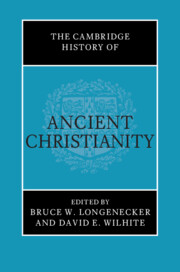Book contents
- The Cambridge History of Ancient Christianity
- The Cambridge History of Ancient Christianity
- Copyright page
- Contents
- Figures
- List of Contributors
- Editors’ Preface
- Part I Contested Contexts
- Part II Contested Figures
- Part III Contested Heritage
- Part IV Contested Cultures
- Part V Contested Beliefs
- 19 Contesting Creator and Creation
- 20 The Trinity in the Making
- 21 Resurrection, Transformation, and Deification
- 22 The Eucharist in the First Three Centuries
- 23 Office, and Appointment to Office, in Early Christian Circles
- Part VI Contested Bodies
- Ancient Sources
- Modern Authors
- References
21 - Resurrection, Transformation, and Deification
from Part V - Contested Beliefs
Published online by Cambridge University Press: 23 August 2023
- The Cambridge History of Ancient Christianity
- The Cambridge History of Ancient Christianity
- Copyright page
- Contents
- Figures
- List of Contributors
- Editors’ Preface
- Part I Contested Contexts
- Part II Contested Figures
- Part III Contested Heritage
- Part IV Contested Cultures
- Part V Contested Beliefs
- 19 Contesting Creator and Creation
- 20 The Trinity in the Making
- 21 Resurrection, Transformation, and Deification
- 22 The Eucharist in the First Three Centuries
- 23 Office, and Appointment to Office, in Early Christian Circles
- Part VI Contested Bodies
- Ancient Sources
- Modern Authors
- References
Summary
In the earliest period of the Christian movements, resurrection meant many things to many people. Claims that resurrection is unique to Christian discourse or unattested in Greco-Roman thought are based on overly determined understandings that respect neither the diversity of early Christian conceptions nor the breadth of Greco-Roman lore.1 The explosion of research on resurrection forbids a comprehensive survey. In this essay, the focus will be on ontology – what resurrection meant for the body, a body different from yet in continuity with the celestial and deathless body it becomes. From this discussion follows an inquiry as to what resurrection meant with regard to human identity: Do resurrected individuals remain human, or do they transcend humanity to become a higher entity?
- Type
- Chapter
- Information
- The Cambridge History of Ancient Christianity , pp. 491 - 513Publisher: Cambridge University PressPrint publication year: 2023



